Some Frequently Asked Questions about Solar Eclipses
Skip to:
What is an eclipse? What is a solar eclipse? What is a lunar eclipse?
What's the difference between a total, partial, and annular solar eclipse?
How often do solar eclipses happen?
Your eclipse dates and times are wrong!
What is Eclipse Magnitude? Eclipse Obscuration?
Is a 90% / 99% / 99.9% partial solar eclipse as good as a total solar eclipse?
What's it like during a total solar eclipse?
How can I watch a solar eclipse safely?
Travel and location safety
What are eclipse glasses / eclipse shades / eclipse viewers / eclipse filters / solar filters?
......and where can I get them from?
How do I take photos of a solar eclipse?
What other eclipse websites are out there?
If you want specific details and maps of Australia's five total solar eclipses in 15 years, see our pages for each of them:
20 April 2023
22 July 2028
25 November 2030
13 July 2037
26 December 2038
What is an eclipse?
What is a solar eclipse? What is a lunar eclipse?
In astronomy an eclipse is simply Something moving in front of Something Else, and blocking the view of the Something Else.During a solar eclipse the Moon moves in front of the Sun, as seen from Earth. During a lunar eclipse the Earth moves in front of the Sun, as seen from the Moon.

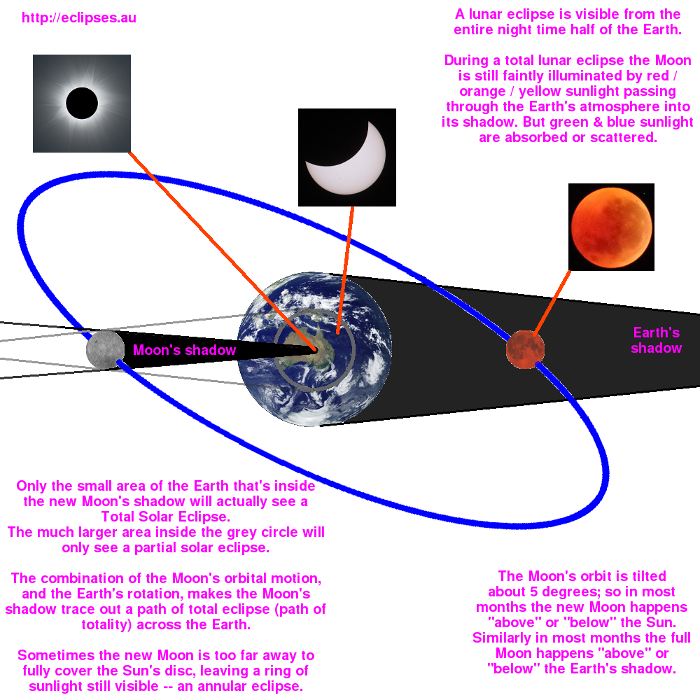
If the Something looks much smaller than the Something Else, then astronomers describe the event as a transit of the Something across the Something Else. For example the planets Mercury and Venus occasionally transit the Sun, as seen from Earth.
What's the difference between a total, partial, and annular solar eclipse?
It all depend on where the Moon's shadow is, in relation to where you are on Earth.During a total eclipse the Moon's shadow is on the Earth's surface, and you're inside the shadow. The Sun is completely hidden from view by the Moon for a short time. Read "what's it like..." below.
During an annular eclipse the Moon is too far away for its shadow to reach the Earth's surface. Most but not all of the Sun's disc is hidden by the Moon, leaving a bright ring of sunlight still visible around the Moon.
Total and annular eclipses are preceded and followed by about an hour of partial eclipse; unless they're happening near local sunrise or sunset. A just-after-sunrise event may begin with a partial eclipse underway at sunrise. Similarly a just-before-sunset event may end with a partial eclipse at sunset.
During a partial eclipse the Sun's disc is only partly hidden by the Moon. The Moon's shadow (and any total eclipse) is far away from wherever you are...and might not even be anywhere on the Earth's surface at that moment. If less than 3/4 of the Sun is covered you may not even notice a partial eclipse is happening.
How often do solar eclipses happen?
For the entire Earth during the 21st century there will be 224 solar eclipses: 77 partial, 72 annular, 68 total, and 7 which are combined annular+total (such as 20 April 2023). That's 75 total eclipses somewhere on Earth in 100 years, or an average of 3 total eclipses per 4 years. But many of those eclipses will only be visible from hard-to-reach places like the middle of an ocean.Total eclipses aren't evenly spaced in time either. For example there's only 176 days between the eclipses on 6 December 2067 and 31 May 2068, but there's 856 days between the total eclipses on 22 July 2028 and 25 November 2030.
At any specific point you might be waiting for a very long time between total solar eclipses. For example the most recent and the next Total Solar Eclipses in Australian capital city centres are:
- Adelaide: 4 March 1802 --- 8 January 4039 (yes, over 2200 years!).
(but Adelaide does see the 6 February 2418 annular eclipse, and its northernmost suburbs today will be just inside the 11 May 2795 total solar eclipse) - Brisbane: 8 August 1831 --- 13 July 2037 (106 years).
(Brisbane also sees the 27 January 2093 total solar eclipse) - Canberra: 4 July 1247 --- 31 May 2337 (1090 years)
(but Canberra does see the 14 October 2042 annular solar eclipse) - Darwin: 24 June 1256 --- 13 October 2349 (1093 years)
(but the 14 November 2012 total solar eclipse began near Darwin) - Hobart: 9 May 1910 --- 29 November 2551 (641 years)
- Melbourne: 23 October 1976 --- 4 April 2220 (244 years)
- Perth: 27 July 1310 --- 16 October 2851 (1541 years)
(but Perth city centre is only two kilometres outside the northern limit of the 31 May 2068 total solar eclipse) - Sydney: 26 March 1857 --- 22 July 2028 (171 years)
(Sydney is the first Australian state/territory capital city centre to see two total solar eclipses. It also sees the 11 April 2089 annular solar eclipse, and its southernmost suburbs today will also see the 14 October 2042 annular solar eclipse)
Your eclipse dates and times are wrong!
All of the solar and lunar eclipses listed on this website have the correct Australian local dates and times.Also we live in Australia, so we know all about Australia's three major time zones, and the several smaller official (and unofficial) local time zones such as Eucla Time. Plus which Australian states and territories use Summer (or Daylight Saving) time, and when....
Astronomers identify a solar eclipse by the date and time when the axis of the Moon's shadow passes closest to the Earth's centre. Similarly, a lunar eclipse's date and time is when the centre of the Moon passes closest to the axis of the Earth's shadow. Astronomers normally describe these moments using Universal Time, which is many hours different from Australian time zones. For example the November 2012 total solar eclipse was officially defined to occur at about 22:13 on 13 November 2012, in Universal Time. But in northern Queensland it was the morning of 14 November.
Lunar eclipses, of course, can begin before local midnight and end after local midnight...and thereby even begin and end in different months like the Jan-Feb 2037 total lunar eclipse!
As for the exact times of when eclipses begin and end:
- For lunar eclipses we express the event times to the nearest minute. The Earth's shadow edge upon the Moon is blurry because the Earth's atmosphere absorbs and scatters sunlight into and around the shadow. So any point on the Moon's surface will take many seconds to pass through the shadow's blurry edge from sunlight to eclipsed. Therefore in our opinion the "edge" is a semantics problem as well as a mathematical one.
Astronomers predicting lunar eclipse events to the nearest second should also be mentioning which of the several mathematical approximations of the Earth's shadow they're using in their calculation. - For solar eclipses the Earth's gradually slowing rotation rate has to be included in the calculations. In fact it was archaeological records of ancient eclipses that first showed the Earth's rotation was slowing down.
The slowdown in rotation is mostly due to tidal forces from the Moon and Sun, but the slowdown rate is not constant and it can change unexpectedly (as it did in 2020-21).
This leads to a discrepancy between the time measured by modern atomic clocks (assumed to be unvarying) and "the time" measured by the Earth's rotation (Universal Time + your time zone offset, used for everyday life).
Astronomers describe the difference in these times as the Delta-T parameter.
Delta-T can be calculated for past years from historical observations, but forecasting Delta-T for future years requires various assumptions. And the forecasting becomes increasingly unreliable as you go further into the future.
An error in the (predicted) Delta-T will displace the eclipse path in longitude; and can change eclipse event times by many seconds especially for locations near the edges of the path. For example if Delta-T for the 25 Nov 2030 eclipse is one second less than predicted, then the eclipse path through South Australia shifts almost 400 metres eastwards. - For the beginning (or end) of a partial solar eclipse we express the time to the nearest second. There's no point being any more precise because "the Sun's disc 1 second after the eclipse starts (or ends)" looks practically the same as it did 2 seconds earlier. The beginning of a partial eclipse normally isn't noticeable for several seconds, unless you're observing the exact point on the Sun's edge at very high magnification. It's easier to spot the moment when a partial eclipse ends.
- Total solar eclipse times are expressed to 0.1 second; after correcting for the Moon's actual topographic outline at the time of eclipse.
Lunar topography corrections become significant near the north and south limits of the total eclipse path (for example). Sunlight shining through deep valleys or depressions along the Moon's edge can change the times of a total eclipse's beginning and/or end by many seconds. Or even prevent a fully total eclipse from occurring at all, because bits of bright sunlight will always be visible (sometimes known as a Beaded Total Eclipse).
Conversely, sunlight may be blocked for an extra few seconds by conveniently-placed lunar heights. And just to make the problem even more difficult, the Moon "wobbles" as it orbits the Earth, so its exact outline is always changing. Fortunately the wobbling angles are well known and predictable.
Nowadays thanks to the laser altimeters aboard the Kaguya and Lunar Reconnaissance Orbiter missions, it is now possible to generate detailed topographic maps of the Moon, calculate its actual topographic outline during a solar eclipse, and thereby calculate eclipse times anywhere in the path to sub-second accuracy. One of the largest remaining causes of inaccuracy is that we don't know the precise diameter of the Sun, nor if it's constant.
Solar eclipse calculations that assume the Moon is a smooth featureless sphere can still predict the location of the eclipse centre line to <100 metres accuracy, and the eclipse times near the centre line to accuracies of a couple of seconds. For eclipse tourism this is "good enough". - Solar eclipse timings for cities and towns will also depend on your choice of its geographic location. Is there a distinct town centre or central business district? If the town centre is clearly offset from the centre of population, should you be using the latter instead? For many Australian towns and cities, their listed geographic coordinates were traditionally the position of the town's main Post Office or Telegraph Office.
What is Eclipse Magnitude? Eclipse Obscuration?
For solar eclipses:- Magnitude = the fraction (0.0 to 1.0) of the Sun's diameter that is covered by the Moon. For a total solar eclipse, the Magnitude is slightly greater than 1.
- Obscuration = the fraction of the Sun's disc area that is covered by the Moon.
For lunar eclipses, the magnitude is the fraction or percentage of the Moon's diameter that is covered by the Earth's shadow. Because the Earth's shadow is much larger than the Moon, a lunar eclipse Magnitude can be much larger than 1.
Is a 90% / 99% / 99.9% partial solar eclipse as good as a total solar eclipse?
NO!
And here's an analogy...
- A Total Solar Eclipse is like being in the best seats of the greatest concert or show or sports event you've ever been to.
- A 99.9% partial eclipse is like being in the carpark outside of that concert. You might be able to hear some of the music, some of the time, but not very well. You may even get hints of the lighting effects. But try telling your friend, who was actually in the best seats, about your Fabulous Concert Experience and they'll just laugh at you.
- A 99% partial eclipse is like being in the same suburb as the concert. You see a lot of extra traffic and visitors but that's about it.
- A 90% partial eclipse is like being in the same metropolitan area as the concert. You may not even notice that it's happening unless you knew about it in advance.
What's it like during a total solar eclipse?
A total eclipse is preceded (and followed) by about an hour of partial eclipse. So your first indication of the event is when a tiny "dent" appears on the edge of the Sun's disc. That "dent" is the edge of the approaching Moon, and during the next 30-40 minutes that tiny dent becomes a big circular bite out of the Sun's disc. Yet the landscape around you seems as bright as ever because the decrease in sunlight, so far, is no different to the Sun going behind a small cloud. If you didn't know there was a solar eclipse today you may not even notice anything unusual. But if you look at the shadows cast by foliage, you notice all of the usual round sun-dapples have become bright crescents. Natural pinhole projections...and those crescents are slowly shrinking.About 10 minutes before total eclipse, you suddenly notice the sunlight doesn't feel warm anymore. The air is getting colder. The sky is developing a curious twilight-blue colour. Shadows are looking increasingly sharp-edged, as though they're being cast by continuous lightning or an Arc Welder. You look through your eclipse filter at the Sun, which is now a brilliant but rapidly shrinking crescent.
And then you look at the western sky, about five minutes before total eclipse, and you see a vast and silent Darkness has appeared there. And then you realise it's rushing towards you, casting the land and any clouds beneath it into blackness. The landscape around you is rapidly falling into the darkness of deep twilight. Colours are reducing to shades of grey. Birds and other wildlife are behaving as though it's a sunset. The Sun has shrunk to an ever-thinning crescent, which breaks into an arc of brilliant pinpoints. And as the last pinpoint of sunlight vanishes, you remove your eclipse filter, and then you see it...
Total. Solar. Eclipse.
You are in the Shadow Of The Moon. The Sun you knew has vanished; replaced by a black disc surrounded by a soft white halo. This halo -- the Sun's corona -- is about as bright as full moonlight next to the black disc, fading into the background sky darkness away from the disc. At the very edge of the black disc, you might see tiny red glows within the corona. These red glows are solar prominences, ever-changing and never repeating clouds of hot gases poised above the Sun's edge. As your eyes adapt to the deep twilight darkness, you see the corona is textured with delicate-looking lines and rays and streamers, sculpted by the complex magnetic fields above the Sun. You imagine tangled hair, tentacles, spines, flames reaching into the sky. No single photo, no video, has ever shown it like this.
You tear your gaze away from the Thing that has replaced the Sun. The sky is not the black of deep night, but you can see some of the brighter stars and planets. The vast Darkness overhead is surrounded by sunset sky colours on every horizon. You hear other people shouting, cheering, screaming with excitement. Or struck utterly silent in reverent awe.
You think briefly, and with pity, about the guy who said he was going to stay home and watch a 99% eclipse. He's not seeing the Thing, its vast Darkness, the un-earthly sky, the ecstatic witnesses...but YOU are.
And then you notice the western horizon's sunset seems to be rising and getting brighter. So you return your gaze to the Thing. You sense that the black disc has moved across the corona since the beginning of total eclipse. The normal daytime sky is about to return. It begins with a searingly-bright pinpoint of sunlight on the edge of the black disc, quickly joined by other pinpoints. The corona vanishes; blotted from view by the returning sunlight. Within seconds the pinpoints have merged into a dazzling curved line of sunlight. If you want to keep watching you'll need your eclipse filter again.
A crescent Sun returns, but now it's facing the other way, and during the next 10 to 15 minutes the warmth of the sunlight and the normal colours and shadows of the landscape return. It's still another 45 minutes or so before the Moon moves completely off the Sun, but already it looks like a normal day again. Except for the excited witnesses, and the question uppermost in all of their minds:
WHEN AND WHERE CAN I SEE MY NEXT TOTAL SOLAR ECLIPSE?
How can I watch a solar eclipse safely?
a.k.a. "I don't want to burn my eyeballs....or die of thirst in a desert."
Looking directly at a TOTAL solar eclipse requires no eye protection at all and is quite safe. The Sun's light is being totally blocked by a ball of rock about the same size as Australia -- but only for the duration of the total eclipse. At all other times when you look directly at the Sun, you will need to protect your eyes with a solar filter product (a.k.a. eclipse glasses / eclipse shades / eclipse viewers / eclipse filters). We discuss these products below. And whenever you're looking directly at a partial solar eclipse or an annular solar eclipse, your eyes will need to be protected at all times.There are other ways to safely view the Sun if it's not totally eclipsed. For example:
- The classic Pinhole Projection method. All you need is a piece of cardboard (or thick paper) with a small hole in it, plus a white or light-coloured surface to project the Sun's image onto. This may be another piece of card. The hole should be 3 to 5 millimetres in diameter, without ragged edges. Try making the hole with various size nails, Philips-head screwdrivers, or hole punches. Try making holes in various patterns for artistic effects. But don't look directly at the Sun through the holes.
You may have items at home that include suitable holes. For example cheese graters, colanders, loosely-woven straw hats or straw matting.
The foliage of many Australian native trees and shrubs provides a multitude of natural "pinholes" and Sun images in their shadows. During partial eclipses these images will appear as crescents. Put a white sheet on the ground to improve the view. - Projection from a monocular, a binocular or a very small telescope. This will produce a larger and brighter image than Pinhole Projection and is good for safely showing a partial eclipse to groups. Visibility of the image will be improved if it's in a shadow (see our photo below).
But:
- Never leave this equipment unattended.
- Never let anyone look through the monocular / binocular / telescope at any time.
- Ensure that all lenses, mirrors, eyepieces (and their mountings) contain no plastic parts at all. Unfortunately a lot of the cheaper telescopes and binoculars use plastic parts; and intense, concentrated sunlight will melt or burn them. Metal parts can get hot enough to cause burns. Glass in eyepieces may crack from the thermal stress. Which is why we don't use expensive eyepieces for this job...and we would never use a larger telescope.
- A specialised solar telescope. Designed specifically to look at the Sun but useless for looking at anything else. And not cheap either. But the views through them are fascinating.
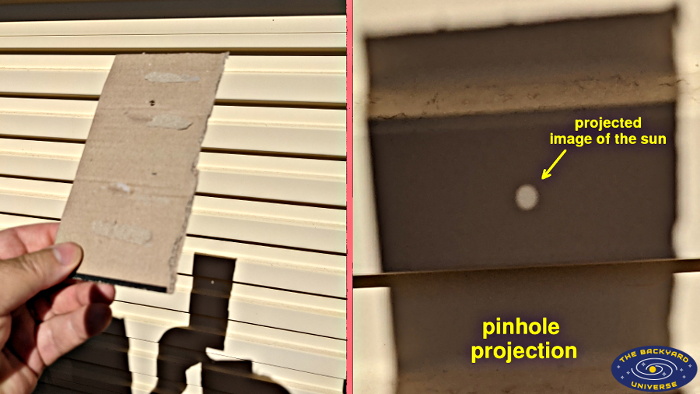
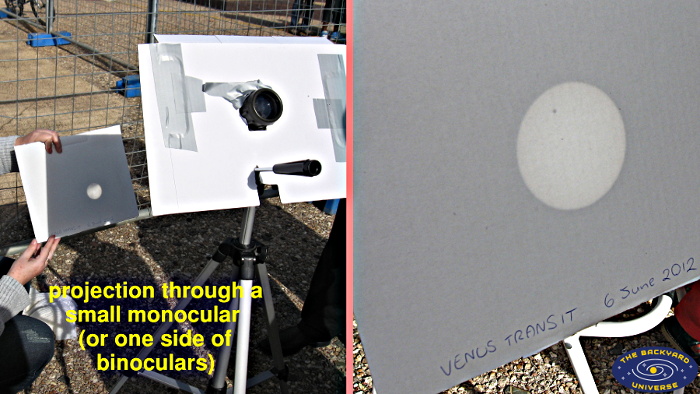
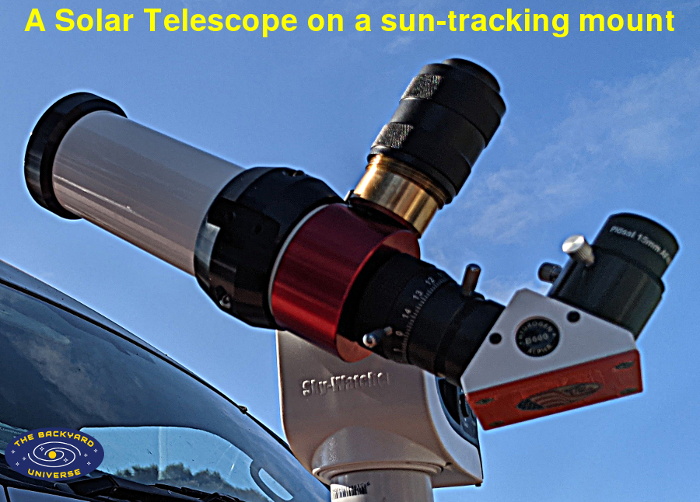
Of course watching a lunar eclipse requires no eye protection at all.
What are eclipse glasses / eclipse shades / eclipse viewers / eclipse filters / solar filters? And where can I get them from?
These are all products specifically designed to let you look safely at the Sun:- Eclipse glasses a.k.a. eclipse shades -- Intended to be worn like regular sunglasses. The frame is made from a double layer of heavy paper or light cardboard, with the special polymer solar filter material sandwiched between the layers where the lenses would be on regular sunglasses. Generally not convenient if you need to wear prescription glasses, because you will have to hold the the eclipse glasses in place over your usual glasses.
- Eclipse viewers -- Similar construction to the eclipse glasses, but in the form of a small postcard with a window of solar filter material in it. Intended to be held in front of your eyes. This is the better option if you already wear prescription glasses. The card can also be combined with a cut-out paper plate or cardboard box to make a little kid's "eclipse facemask".
- Eclipse filters -- Usually means the un-mounted polymer filter material, sold as a sheet or a roll. Intended for people who are making a custom filter to put on the front of their own telescopes / binoculars / cameras.
- Solar filters -- Intended for installation on the front end of telescopes or cameras, and usually manufacturer-specific. Sometimes made from specially coated optical glass instead of polymer filter material, supported in a metal ring or sleeve. Some manufacturers also sell sun-viewing-only versions of their telescopes or binoculars, with solar filters permanently installed.
Before each use, check that your product has no scratches / abrasions / pinholes or other damage, and that it hasn't separated from its frame or mounting.
Use a lightbulb, rather than the sun, for this safety check.
The current International Standard for all these solar filter products is ISO 12312-2 (2015),
which has been adopted in Australia -- unchanged -- as the Australian Standard AS ISO 12312.2 :2020.
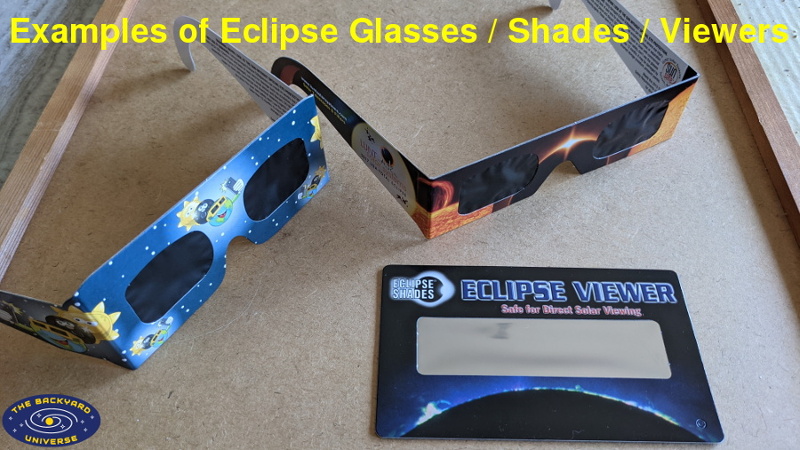
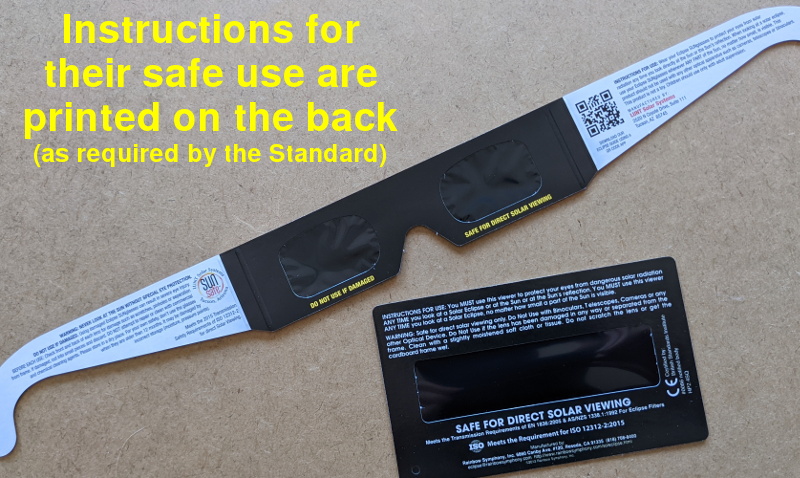
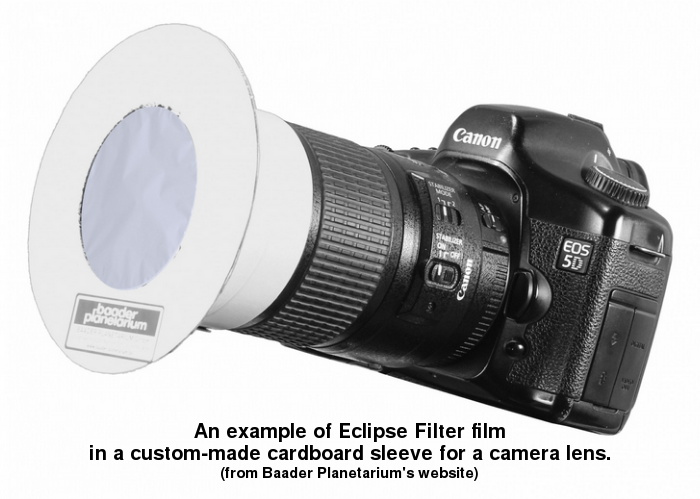
Products that comply with ISO 12312-2 / AS ISO 12312.2 are safe for looking at the Sun, when used as directed.
And the Standards require the directions for safe use to be printed on the products (as shown above).
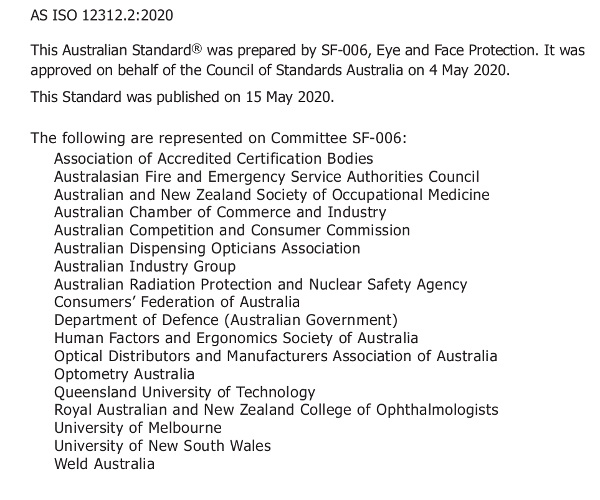
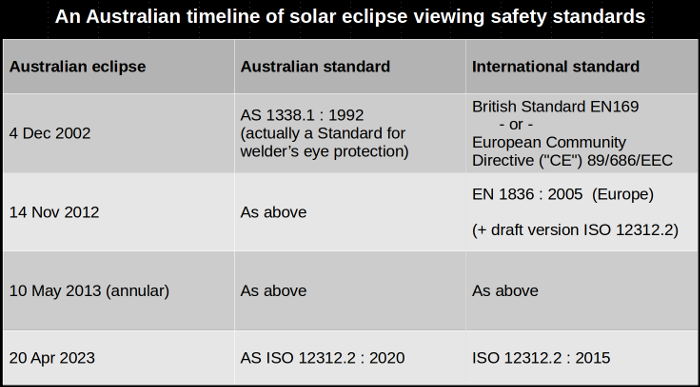
Use a bright light -- NOT the Sun -- to check your solar filter for any pinholes / scratches / cracks.
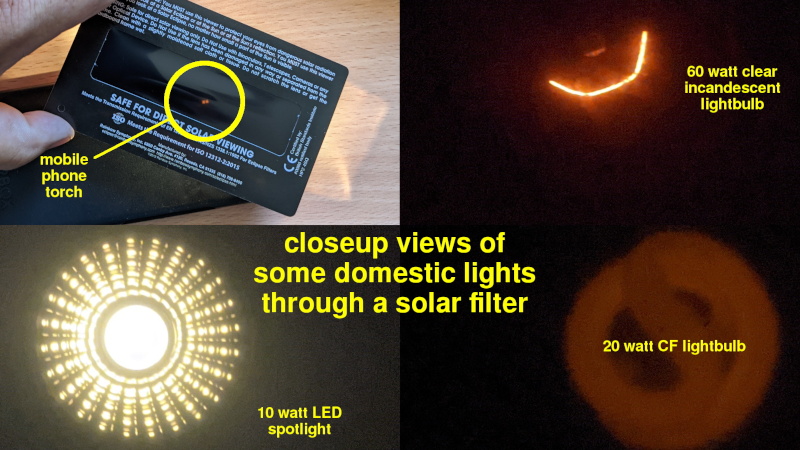
You should buy your solar filter products (glasses, viewers, etc) long before eclipse day.
which has been adopted in Australia -- unchanged -- as the Australian Standard AS ISO 12312.2 :2020.



Products that comply with ISO 12312-2 / AS ISO 12312.2 are safe for looking at the Sun, when used as directed.
And the Standards require the directions for safe use to be printed on the products (as shown above).


Use a bright light -- NOT the Sun -- to check your solar filter for any pinholes / scratches / cracks.

Total solar eclipses nowadays attract huge audiences, especially if they happen to pass over large cities such as Sydney or Brisbane. Or if they occur soon after a huge audience has seen another total eclipse recently. And everyone will want a solar filter to use on eclipse day. And many of the first-time eclipse watchers won’t think of getting a filter until a week or so beforehand, believing solar filter products are as readily available as beer or bread. Which is when they discover most of the reputable sources have already sold out and won't have new stocks available until after eclipse day.
Which then leads to:
- SCALPERS selling genuine solar filter products at highly inflated prices, and...
- COUNTERFEITERS promoting fake (and unsafe) "filters", made cheaply from things like builder's black plastic film or foil blankets, and also sold at inflated prices.
The counterfeiters often copy reputable manufacturers' logos and trademarks, claim approval from NASA or other space agencies, and frequently will include fake "certification" too.
The best way to avoid scalpers and counterfeiters is DO NOT BUY YOUR SOLAR FILTER PRODUCTS from places like Amazon or Ebay or Facebook Marketplace or Gumtree. Because the scalpers and counterfeiters infest these kinds of marketplaces during the weeks before every solar eclipse.
Buy your eclipse glasses / viewers / shades directly from these manufacturers, or from Australian retailers who can demonstrate their stock came from these manufacturers
(this list is in alphabetical order)
- American Paper Optics -- www.eclipseglasses.com
- American Paperwear --- ampaperwear.com
- Baader Planetarium -- astrosolar.com/en
- Daystar Filters -- www.icstars.com/Store/daystar
- Lunt Solar -- luntsolarsystems.com
- Rainbow Symphony -- www.rainbowsymphonystore.com
- Thousand Oaks Optical -- thousandoaksoptical.com
Large orders directly from the manufacturers can be customised with your own design or logo, and the per-item cost is considerably lower.
We discovered that smaller orders directly from some international suppliers to our Australian rural address defaulted to eye-wateringly high shipping costs. It's well worth asking them directly if they can send your order as an ordinary international parcel that's delivered to you by Australia Post. We found it reduced the shipping costs to us to about 1/10 of the default price, and we still got the parcels in a couple of weeks.
The American Astronomical Society also maintains a list of reputable manufacturers and retailers.
Some Australian retailers of various safe solar filter products include (in alphabetical order):
- Astro Shop -- www.astroshop.com.au
- Binocular & Telescope Shop (Bintel) -- www.bintel.com.au
- Celestron Australia -- www.celestron.com.au
- Optics Central -- www.opticscentral.com.au
- Sirius Optics -- www.sirius-optics.com.au
- Skywatcher Australia -- skywatcheraustralia.com.au
Notes on specific products / suppliers:
- Baader Planetarium's newer AstroSolar Gold Film and AstroSolar Silver Film are both fully compliant with ISO 12312.2. Their older product AstroSolar Safety Film. sold as sheets or rolls, complied with the older European Union safety standards but lets through slightly too much ultraviolet light to comply with the more stringent ISO 12312.2. So by itself it won't fully protect your eyeballs.
However the combination of AstroSolar Safety Film + a thin layer of glass (which blocks ultraviolet) is compliant with ISO 12312.2; so AstroSolar Safety Film is safe to use on a telescope / binocular / camera / mobile phone. It's also safe when used in front of your prescription glasses. - Celestron also sells sun-viewing-only versions of some of their telescopes and binoculars; with solar filters permanently installed.
- Daystar and Lunt Solar both also sell hydrogen-alpha Solar Telescopes; another safe (but expensive) way to view the Sun.
- Skywatcher also sells the Solarquest Heliofind mount; which uses a GPS-equipped sun sensor to automatically find and track the Sun. Use it with their Solar Telescope or yours. Or with cameras (you will also need a dove-tail adaptor bracket).
- Incidentally a Shade 12 or darker Arc Welding eyeshield also happens to comply with ISO 12312.2. Although many people will think the sun is still too bright through Shade 12 and would prefer a darker Shade 13 or 14. Or a Shade 12, in front of their sunglasses. Don't use an auto-darkening electronic welder's helmet; most of them only go to Shade 11 which isn't safe enough for directly viewing the sun.
The two simple rules to remember about positioning your safe solar filter product:
- THE SUN
--then--
YOUR SOLAR FILTER PRODUCT
--then--
your eyeballs / camera / binoculars / telescope / mobile phone. - THE FILTER MUST BE USED AT ALL TIMES, except during the brief moment of Total Solar Eclipse.
And if you're not expecting a total solar eclipse where you are, then don't stop using the filter at all.
Filters that are stored inside a sealed container or envelope will last for many years in cool, dry conditions. Before using an old solar filter again, check that it has no scratches, abrasions, pinholes or other damage, and that it hasn't separated from its frame or mounting. Use a lightbulb, rather than the sun, for this safety check (see the photos above).
And finally, here's a list of some so-called "sun filters" that are UNSAFE !
- Regular sunglasses. It doesn't matter if they cost $2 or $20,000. NONE of them are designed for directly viewing the Sun safely (the $20,000 sunglasses may even include a warning about not staring at the sun...).
- Any type of tinted or coloured glass, including beer bottles and wine bottles.
- Tinted windows in cars and other vehicles, and tinted windows in buildings.
- Polarisers, Neutral Density Filters and other coloured or tinted filters for cameras.
- Any type of photographic film, exposed or not.
- All CD-ROMs, DVD-ROMs and Blu-Ray discs.
- Floppy disks (if you have no idea what these are, ask someone born before 1990...).
- Wine cooler bags, space blankets, foil emergency blankets, food wrappers, snack bags, plastic sheets (including aluminised Mylar), and plastic containers or plastic lids.
- Any thin cloud in front of the Sun.
- ...and Great-Granddad's favourite, a piece of Smoked or Sooty Glass.
The damage to your eyesight from unsafe viewing of the sun is painless (because your eyeball contains no pain nerves), but it is PERMANENT and IRREVERSIBLE.
Travel and location safety
This is an overlooked aspect of eclipse safety, so we've included a lot of more specific comments on each of the eclipse pages for 2023, 2028, 2030, 2037 and 2038. Most of Australia is sparsely populated and has long driving distances between towns and the various state/territory capitals. Which is why Australia has a well-developed domestic airline and air charter industry, as well as several international airlines offering direct flights into various Australian cities.Nearly all of Australia's highways outside of the major cities provide only a single traffic lane in each direction, and there are many long intervals where there are no safe (or legal) overtaking opportunities if you're behind a slower vehicle. Heavy vehicles are maximum speed limited to 100 kilometres per hour; but they may be going slower if they're carrying dangerous or oversize freight. Many motorhomes or caravans aren't in a hurry either, and some of their drivers never look in their rear view mirrors.
So if you intend to drive many hundreds of kilometres to an eclipse then don't do it all on eclipse day. Traffic on eclipse day will be intense, all of it will be travelling at the speed of the slowest vehicle, there will be queues for fuel (and recharging), and there will be some breakdowns or accidents causing more delays. Also don't plan on driving many hundreds of kilometres immediately after the eclipse. Plan on staying in (or near) the total eclipse path for a few days instead, before and after the eclipse. Catch up with friends out there, compare and share your experiences, and check out some non-eclipse things to do in the district. Make the eclipse an important, but not the exclusive, reason for your visit.
If you're hoping to see the eclipse from a roadside in the middle of nowhere:
- Check your car before you leave home (or leave the car rental place). Is there any maintenance due? Is the spare wheel aboard, and correctly inflated? Do you have the other tools (and knowledge) to change a flat tyre on your car? Don't rely on Roadside Assist getting to you quickly.
Do all your car's lights and turn indicators work? If you're carrying things on a roof rack or in a trailer or in a ute tray, are they securely tied down?
- If you're towing a caravan or trailer; also check its lights, turn indicators, brakes, tyres, spare wheel(s) and wheel bearings before you leave home.
- Do you know how far apart your car's refuelling or recharging stops will be? Where and what do you plan to eat? Where are you staying, and do you need to pre-book this accommodation?
- Check the latest weather and road conditions reports; especially if you plan to be driving on unsealed rural or Outback roads. You do not want to be the fool who gets trapped in the middle of nowhere for days, because you drove out there just before the predicted flooding began.
- Find somewhere to park where you won't obstruct passing traffic. Regular traffic in the rural and Outback parts of Australia includes lots of double semi-trailers, plus triple and quadruple road trains.
Some roadside parking areas are specifically for trucks and other heavy vehicles and should not be used by cars. - Did you bring a chair or a picnic blanket to sit on, while you wait for the eclipse? Did you also bring water? Snacks? Other drinks? Sunscreen and a hat, or something to provide shade?
- Do you need any essential medications out there with you? Do they need to be kept cold?
- If you're camping out there, did you check and pack all of your camping equipment? And food? And water?
- What are you using for a toilet? Leaving used toilet paper and excreta on the landscape is disgusting and unhygenic -- use a shovel and bury it out of sight! Better still, bring a self-contained chemical toilet or a "thunder bucket", and dispose the contents into an RV Dump Point or your toilet at home.
- Do you have a first aid kit? And someone who knows first aid?
- Mobile phone coverage is limited or non-existent in many parts of Australia. Consider travelling in a group of vehicles, or bring a satellite phone, or a satellite distress beacon. At the very least, let someone else know of your travel plans and when you expect to return -- so they can raise the alarm if you're "missing".
- If you get bogged or have a mechanical breakdown in a remote region then STAY WITH YOUR VEHICLE until help arrives.
A car is much easier for rescuers to find, and people in rural or Outback Australia have died from thirst or exposure while attempting to walk for help.
How do I take photos of a solar eclipse?
Your camera will need to be protected by a solar filter at all times -- except during the brief moments of total eclipse. The solar filter should be removed during total eclipse otherwise your camera won't be able to see it. Then as soon as the total eclipse ends, the solar filter needs to go back on your camera. Or you can use two cameras: one without a filter to be used only during total eclipse, and one with a filter to be used at all other times.
If this is your first solar eclipse then take a few photos of it if you want,
but don’t waste your time trying to get that perfect photo of total eclipse.
LOOK at it with your eyes instead.
but don’t waste your time trying to get that perfect photo of total eclipse.
LOOK at it with your eyes instead.
There will be lots of beautiful photos posted online by experienced eclipse photographers afterwards. Who are using thousands of $$$ of equipment and taking multitudes of fully automated and pre-rehearsed exposures. Afterwards these photographers spend hours on their computers, processing & compositing these multiple images into "a total eclipse photo". Some of these composite images will get close to what your eyeballs can see directly.
Some of these experienced photographers have posted detailed eclipse photography advice here and here and here.
You will need to have full manual control of every aspect of your photos / videos to get images this good. Auto-focus, auto-exposure time, auto-zoom, auto-ISO, etc are all useless for eclipse photography; because the "auto-..." was designed for photos of scenery or people, not for astronomy. Another challenge for total solar eclipse photographers is the enormous brightness range of the solar corona; from "as bright as full moonlight" nearest the (eclipsed) Sun, fading to the same brightness as the deep twilight of the total eclipse sky. You won't capture all of it in a single image; you will need multiple exposures at varying settings to be composited later. If your camera can do Exposure Bracketing then use it for each photo too.
Also, don't use Digital Zoom unless you want your eclipse close-up to look like a 1980s arcade game. You need genuine optical zoom or optical magnification.
Good digital cameras will allow you to selectively turn off their auto-features and manually control everything. Even cheap pocket digital cameras (and most mobile phone camera apps) will let you manually specify some settings, such as exposure times and ISO sensitivity. For recent model mobile phones, you can manually focus their standard camera app by pressing a fingertip to the exact part of the image you want to focus (such as the Moon's edge). Then tap the part of the image you're interested in to adjust the exposure time. If you're attempting a video of total eclipse, you will definitely need to manually specify all settings, and be prepared to vary them.
The Sun is going to move about 15 degrees across the sky between the start of partial eclipse and the beginning of total eclipse. After total eclipse ends the Sun will move about 15 degrees across the sky again until the end of partial eclipse. Is your camera's view of this 30 degrees of sky going to be obstructed by trees, buildings, hills, or late-arriving dimwits who park themselves between you and the eclipse? If it's an early morning or late afternoon eclipse then the horizon may interrupt the event anyway -- but also provide opportunities for wide-angle "total eclipse over landscape" or "total eclipse next to landmark" photos.
To get an estimate of how big 15 degrees is, spread out your fingers and thumb at arm's length. For most people the angle between their outstretched little finger's tip and their outstretched thumb tip is about 15 degrees.
If you’re still wanting to photograph the eclipse, practice practice, and practice, before eclipse day:
- Use the Moon as a practice target during the weeks before eclipse day. Experiment with different lenses & exposure settings to get an idea of image size and exact manual focusing on your camera. If you have a safe solar filter for your camera you can also use the sun as a practice target, and experiment with the correct exposure times/ISO for the partial moments of the eclipse.
- Unless you're a Living Statue you will almost certainly need to put your camera on a tripod; and use either a Cable Release or your camera's Shutter Delay feature (to avoid vibration caused by you pressing the shutter button). And will you still be a Living Statue during the excitement of total eclipse?
- If you don't have a tripod try using very short exposures combined with a high ISO to "freeze" any camera movement. Or activate your camera's Shake Reduction / Image Stability feature if it has one.
- The ambient lighting during total eclipse is similar to a clear evening twilight 20-30 minutes after sunset. Try practicing with your equipment during twilights prior to eclipse day.
- Practice quickly removing the solar filter from your camera (to photograph total eclipse) and quickly replacing it again (after the total eclipse). Or use two cameras, one without a filter (exclusively for total eclipse) and one with a filter.
- Bring spares of crucial items, such as fully charged batteries, memory cards or remote Cable Releases. Before eclipse day, practice quickly swapping "dead" crucial items for fresh ones.
- If you're using a mobile phone camera, do you have a fully charged battery and enough internal memory space to store your photos/videos? Don't expect to be able to upload to any kind of online storage in real-time. The mobile phone networks (if they even exist where you're viewing from) will be totally overloaded on eclipse day. Like the final moments of New Years Eve, but continuing for hours.
- If your photo equipment breaks during the eclipse don't waste time trying to fix it. It's better to abandon your photo efforts and simply enjoy the eyeball view.
An example of pre-eclipse practice photography:

And before you start any photography on eclipse day...
TURN YOUR CAMERA’S FLASH OFF!
IF YOU CAN'T TURN THE FLASH OFF, THEN COVER IT UP!!
A mobile phone camera flash or a pocket camera flash is easily covered by a blob of Blu Tack -- which is available from practically every supermarket and office supply shop in Australia.
Or you can use black electrical tape, if you don't mind cleaning tape glue off your phone afterwards.
During the dim light of a total eclipse, firing a camera flash towards people's eyes (even by accident)
is guaranteed to make you the target of verbal abuse from angry witnesses.
(and using a bright torch for any reason during a total eclipse is also unwelcome)
And WHAT do you think your camera flash is going to illuminate anyway?
The Moon is about 380 thousand kilometres away.
The Sun is about 150 million kilometres away.
The effective range of a camera flash is about 10 metres....which is useless for scenery or landscape photos.
And if the camera thinks the flash is "on", then it will default to an exposure time that's too short to actually photograph the total eclipse.
DON'T USE A CAMERA FLASH DURING A TOTAL ECLIPSE!

And before you start any photography on eclipse day...
TURN YOUR CAMERA’S FLASH OFF!
IF YOU CAN'T TURN THE FLASH OFF, THEN COVER IT UP!!
A mobile phone camera flash or a pocket camera flash is easily covered by a blob of Blu Tack -- which is available from practically every supermarket and office supply shop in Australia.
Or you can use black electrical tape, if you don't mind cleaning tape glue off your phone afterwards.
During the dim light of a total eclipse, firing a camera flash towards people's eyes (even by accident)
is guaranteed to make you the target of verbal abuse from angry witnesses.
(and using a bright torch for any reason during a total eclipse is also unwelcome)
And WHAT do you think your camera flash is going to illuminate anyway?
The Moon is about 380 thousand kilometres away.
The Sun is about 150 million kilometres away.
The effective range of a camera flash is about 10 metres....which is useless for scenery or landscape photos.
And if the camera thinks the flash is "on", then it will default to an exposure time that's too short to actually photograph the total eclipse.
DON'T USE A CAMERA FLASH DURING A TOTAL ECLIPSE!
What other eclipse websites are out there?
Every solar eclipse website gets huge increases in visitors on "eclipse day", and during the few days prior to eclipse day. This can make them glacially slow or un-reachable. It's like your mobile phone connection on New Year's Eve as midnight is approaching....The reputable websites include these (in alphabetical order):
- American Astronomical Society's eclipse site. Not just for American eclipses; there's a lot of excellent general eclipse information and advice too.
- The Astronomical Society of Australia's 2023 Eclipse site.
- Eclipse Chasers, but use their site search box.
- Eclipsemaps.com Exactly what it says on the label: eclipse maps -- past present and future.
- EclipseWise.com eclipse maps, animations, predictions and advice, by the (retired) former manager of NASA's eclipses website.
- Eclipsophile eclipse weather and climate forecasting.
- International Astronomical Union's Working Group on Solar Eclipses. Links to a vast collection of eclipse resources for professional astronomers and for the general public.
- NASA's eclipse website.
- Oz Eclipse, another Australian's solar eclipse website. We love his portable quick-remove solar filter design.
- timeanddate.com don't just do time conversions and calendars. They also do eclipse maps, animations and predictions.
- xjubier.free.fr -- interactive Google Maps and GPX files of eclipses. You will need an internet connection for the real-time interactive Google features to work.